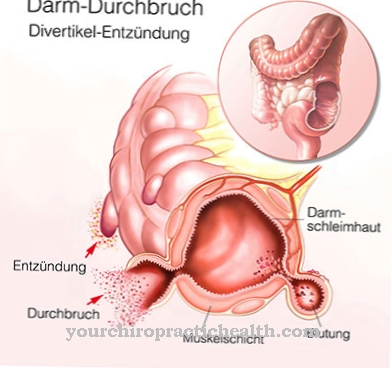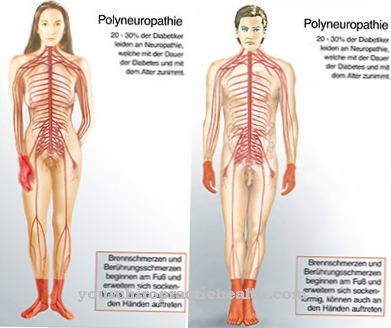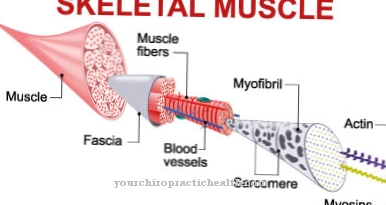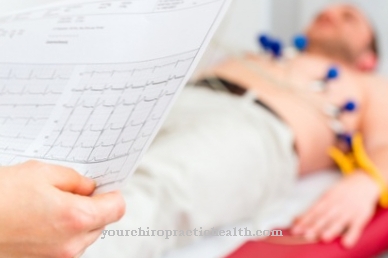Tardive dyskinesias are dystonias that can occur after years or decades of administration of neuroleptics and manifest themselves in the form of a movement disorder. Often the patients grimace or suffer from disturbed breathing or bowel movements. After the manifestation of tardive dyskinesia, the disease is difficult to treat.
What is tardive dyskinesia?

© hkama - stock.adobe.com
Dystonia is a neurogenic movement disorder that originates in motor brain centers and is classified as extrapyramidal hyperkinesia. Most dystonias manifest themselves in cramps or bad posture. In medicine, different forms of dystonia are distinguished. One of them is the Tardive dyskinesia, that is, the belated motor disorder, also called tardive dyskinesia or Dyskinesia tarda is known.
Such movement disorders often affect the facial area and in this case manifest themselves in twitching, smacking or chewing movements, grimacing or other involuntary combinations of movements. In addition to the face, the extremities can also be affected, which is then referred to as hyperkinesis. Medicine knows two different types of tardive dyskinesia.
This form can be associated with severe symptoms of paralysis and mainly affects young people. The clinical picture is also known as drug-induced dystonia because it is often associated with neuroleptics.
causes
Tardive dyskinesia occurs primarily when using older neuroleptics of the butyrophenone or phenothiazine type. Only clozapine does not appear to be associated with tardive dyskinesia. However, olanzapine can cause extrapyramidal movement disorders in a few patients. For conventionally highly potent neuroleptics, a frequency of 15 percent applies.
Additional risk factors for the movement disorder are smoking, brain damage and old age. The side effects of the neuroleptics can occur because the neuroleptic messenger substances also occur in other areas of the nervous system. The dopaminergic transmission of excitation is disturbed by the neuroleptic-induced receptor blockade in the basal ganglia.
This mechanism of action is considered to be the cause of tardive dyskinesia. Tardive dyskinesias are extrapyramidal hyperkinesias and only appear after long-term therapy with the above-mentioned psychotropic drugs. When exactly this manifests itself varies from case to case.
Symptoms, ailments & signs
Tardive orobuccolingual dyskinesia is associated with tics. Patients with this type of tardive dyskinesia grimace rhythmically in the facial area, for example with the entire face, tongue or mouth. Breathing and bowel movement disorders have occurred in very few individual cases.
The same goes for rhythmic movements such as pelvic dyskinesia and continuous hand movements. Mostly younger people often suffer from tardive dyskinesias with considerable impairments or the complete loss of body functions. Symptoms of paralysis are also conceivable in this context.
Particularly characteristic of tardive dyskinesia are repeated involuntary or pointless movements such as puckering or curling of the lips or noticeably rapid blinking movements. Involuntary movements in the extremities are less common. Blepharospasm is also a rather rare symptom.
Diagnosis & course of disease
The diagnosis of tardive dyskinesia is made by a neurologist. In addition to visual diagnostics and anamnesis, images of the skull play a role in diagnostics. The patient's prognosis is relatively poor. Most late kinesias are irreversible and have little response to medication.
Complications
As part of tardive dyskinesia, those affected suffer from various complications. Typical are tics, which manifest themselves in the form of facial twitches, quick blinking, breathing disorders and unusual bowel movements. Compulsive movements can also occur in the area of the back and hands, which ultimately lead to a complete loss of body functions.
Eyelid cramps, which are associated with muscle pain, headache and tension, rarely occur. Those affected suffer from these obsessive-compulsive disorder physically, as regular tics are associated with a range of symptoms. However, the greatest complications are psychological in nature. The characteristic appearance of tardive dyskinesia almost always results in inferiority complexes or depression.
Those affected often withdraw from social life or are marginalized. This additionally increases the level of suffering and significantly reduces the quality of life. Treatment is possible, but it also carries risks.
The typically prescribed drug botulinum toxin is injected by the doctor into the muscle that is affected by dyskinesia in order to achieve relaxation. For example, with disorders of the eye, restricted facial expressions, dry mouth and eyelid cramps. Further drugs should therefore always be taken under the supervision of a doctor.
When should you go to the doctor?
In the case of tardive dyskinesia, the person affected is always dependent on treatment and an examination by a doctor. As a rule, a complete healing can only come about because the disease cannot usually be treated by self-help measures and self-healing cannot occur. A doctor should always be consulted with tardive dyskinesia if the person concerned is suffering from severe symptoms. In most cases, the patients feel permanently tired and exhausted and can no longer actively participate in their everyday life.
Even difficult and strenuous activities can no longer be carried out without problems, so that the everyday life of the person affected is severely restricted by the tardive dyskinesia. If these symptoms occur and do not go away on their own, you should definitely consult a doctor. Involuntary movements or paralysis in different parts of the body can also indicate tardive dyskinesia. Tardive dyskinesia can be recognized and treated by a general practitioner or a neurologist. It cannot be universally predicted whether a healing will result.
Doctors & therapists in your area
Treatment & Therapy
The only causal therapy for patients with tardive dyskinesia is to stop the medication in good time. In many cases, however, this procedure is impractical because the problems are recognized too late. As soon as tardive dyskinesia becomes manifest, patients generally respond inadequately to treatment attempts, since the influence can no longer be revised even when the symptoms set in.
Conservative drug therapy options exist, for example, with dopamine-agonistic agents such as those used in Parkinson's patients. In addition to lisuride and pergolide, movement-normalizing substances such as tiapride or tizanidine are used.
Physiotherapy can play a role in alleviating subjectively distressing symptoms. However, the involuntary movements usually elude voluntary control, so that physiotherapy turns out to be extremely difficult and lengthy. As tardive dyskinesia affects social life to a greater or lesser extent, psychological complaints can occur.
Psychotherapy is indicated if the psyche is already manifest. The patient learns how to better deal with the reactions to his movement disorder. In the recent past, drug therapy has partly used botulinum toxin, which in some cases has at least been able to bring about a temporary improvement in the symptoms.
All drug treatment steps are to be understood as purely symptomatic therapy. In addition, the additional drug administration is associated with other side effects, so that a vicious circle occurs. Since tardive dyskinesia is difficult to treat after manifestation, prophylaxis and risk minimization are one of the most important steps.
You can find your medication here
➔ Medicines for muscle crampsprevention
The newer atypical neuroleptics show significant pharmacological differences to older preparations. Tardive dyskinesias are apparently less common in the newer variants. On the other hand, there are far fewer long-term studies on the newer substances, so that the dyskinesia risk for many of the new developments cannot be adequately assessed.
Each administration of a highly potent typical neuroleptic increases the individual risk of tardive dyskinesia. In this context, there seems to be at least little to be lost through the alternative use of newer and atypical active ingredients. Since the consumption of nicotine also seems to increase the risk, not consuming nicotine can be seen as a further preventive measure.
Aftercare
In most cases of tardive dyskinesia, those affected have very few options for direct follow-up care. For this reason, the person affected should consult a doctor as early as possible and initiate treatment so that there are no complications or other complaints in the further course. As a rule, self-healing cannot occur, so that the person affected should first consult a doctor.
In some cases, the symptoms themselves can be relieved with the help of various drugs. The person affected should always ensure that the medication is taken regularly and that the dosage is correct so that the symptoms can be relieved correctly and, above all, permanently. If anything is unclear, a doctor should be contacted so that there are no complications in the further course.
The help and support from your own family has a very positive effect on the further course of this disease, which can also prevent depression and other psychological upsets. In some cases, tardive dyskinesia also reduces the person's life expectancy.
You can do that yourself
Self-help measures usually cannot make a visit to the doctor unnecessary, because with certain illnesses self-treatment carries an incalculable risk. Tardive dyskinesia is different: it eludes any form of treatment. Patients have to cope with the jerks and involuntary movements in everyday life. Even physiotherapy cannot stop this.
Tardive dyskinesia represents a psychological burden for those affected. Undisturbed communication is hardly possible due to the uncontrollable facial movements. Other people misperceive the body signals sent. It is not uncommon for an illness to lead to social isolation. There is no effective remedy for this. Even trained therapists usually cannot treat such complaints successfully. Only explanations to the interlocutor create clarity and allow less arduous communication.
The impossibility of self-treatment in the case of tardive dyskinesia does not only extend to facial expressions. Twitches on the arms and legs are also possible. They take place in an uncontrolled manner, are not controllable and therefore not accessible for self-treatment. Some scientists recommend stopping nicotine use. The extent to which this leads to a reduction in the unreal motion sequences has not been conclusively clarified.



.jpg)





















.jpg)


